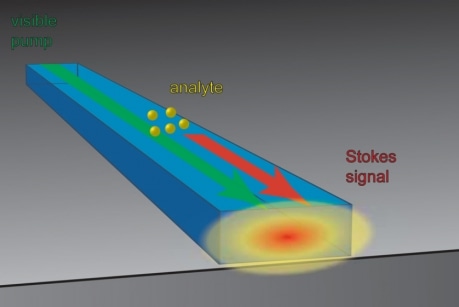Aug 17 2016
A team of Cornell researchers have prepared the groundwork for a chemical sensor on a chip using the expertise in photonics and materials science. The goal is for the chip to be used in small portable devices to monitor air and water quality in the field, examine samples in a lab, and maybe even detect explosives.
 Light traveling through a nanoscale waveguide on a hip spreads beyond the waveguide and can interact with molecules above the surface of the chip. (Credit: Cornell University)
Light traveling through a nanoscale waveguide on a hip spreads beyond the waveguide and can interact with molecules above the surface of the chip. (Credit: Cornell University)
The researchers made use of a phenomenon referred to as “Raman scattering”. When a laser hits a molecule it pushes back the laser energy as photons of light at varied wavelengths that rely upon the composition and structure of the molecule.
For Raman scattering to occur on a chip, the team shoot a laser into a waveguide – a narrow piece of transparent material made of titanium dioxide, where the light rebounds within the inner surfaces and becomes confined to the waveguide. Since a waveguide measures just a few nanometers in height, the light waves disperse beyond the waveguide, developing an “evanescent field” on top of the surface of the chip.
The pumping laser can stimulate Raman scattering in the region above the chip, or in a drop of liquid located on its surface for testing, while continuing to confine the light wave to the chip.
Light pushed back by the excited molecules also trails the waveguide; a prism placed at the end of the waveguide can stretch that light into a spectrum that is a “fingerprint” identifying the molecule that created it.
If you need a chemical sensor in the lab, that is not a problem. But when you are outside, finding a chemical sensor that you can take with you is a challenge. We want to develop a technology that is small enough for a phone, such that your personal electronics can constantly monitor the world around you, and the moment you see something out of the ordinary, the sensor can tell you what it is.
Jin Suntivich, assistant professor of materials science and engineering
Sensors based on Raman scattering is not a new concept. It was performed before using silicon nitride waveguides. The Cornell team has developed a design capable of making a sensor more sensitive and adequately small to be used in the field by using titanium dioxide.
We’re not the first but we’re the best.
Christopher Evans, a Kavli Postdoctoral Fellow in the Laboratory of Atomic and Solid State Physics and the Kavli Institute at Cornell for Nanoscale Science.
Evans, the first author of research paper along with co-authors Suntivich and Chengyu Liu, a doctoral student in the School of Applied and Engineering Physics, describes the new approach in the July 14 online edition of the American Chemical Society journal ACS Photonics.
Titanium dioxide possesses a much higher refractive index, thus making a better contrast with the space on top of the chip, which develops a stronger evanescent field. Furthermore, the material is transparent to light at visible wavelengths, a condition that enables researchers to employ a laser at shorter, visible wavelengths, which stimulates enhanced scattering. The team tested using a green laser pointer as a light source.
For a future device, a miniature laser unit can be constructed into a chip. A component capable of dispersing the wavelengths of the pushed back light onto a photosensitive device to read the spectrum can also be fitted into the chip. One option is to read the spectrum using the phone’s camera.
The length of the waveguide helps increase interaction of the pumping laser with the material above the chip. However the team has a plan to increase the interaction without making the chip larger. A “ring resonator” is a solution.
When a circular waveguide is placed tangent to a straight guide, a portion of the light will penetrate the ring and continue to circle around it, allowing the light to interact repeatedly and constantly with the material above the chip. The ring’s circumference can be modified to resonate with the wavelength of the light, thus increasing the effect.
We have shown that we can increase the amount of peak signal from our sensors by an order of magnitude (or more), while simultaneously reducing the device footprint down to the cross-section of a human hair.
Evans
Portable sensors to monitor the quality of air and water and conduct laboratory tests in the field are examples of probable applications. Chemists could view chemical reactions as they occur.
The research was supported partially by the Cornell Center for Materials Research and used the Cornell Nanoscale Facility, both funded by the National Science Foundation. Additional support was provided by the Samsung Advanced Institute of Technology and the Kavli Institute at Cornell for Nanoscale Science.